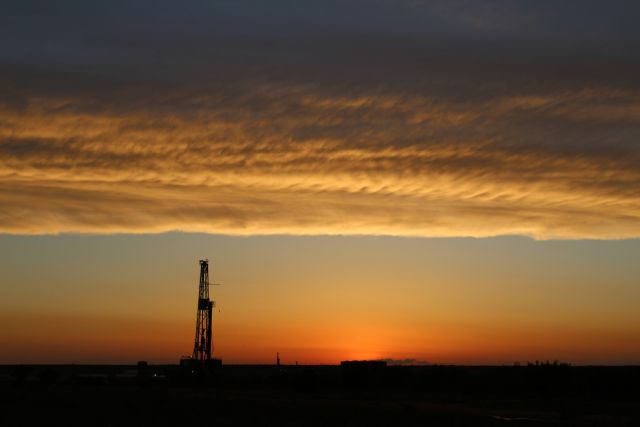
Output gains in the prolific Permian Basin will prop up flattening U.S. oil production and offset declines in other basins, according to Enverus forecasts. (Source: Shutterstock)
Output gains in the prolific Permian Basin will prop up flattening U.S. oil production and offset declines in other basins, according to Enverus forecasts.
While much of the Permian’s supply will be filled by volumes from the Midland and Delaware sub-basins, incremental gains through 2030 will likely come from horizontals drilled in fringier, more extensional parts of the Permian, experts said at the 2024 Enverus Evolve conference in Houston.
The U.S. fueled 9% of global oil production growth over the past 20 years, according to Enverus data.
But overall U.S. production growth will be roughly flat entering the 2030s as E&Ps wade through inventory degradation and operate more frugally with their cash.
Most U.S. E&Ps are in no hurry to pump cash into new drilling projects to grow production. Several of the largest U.S. producers are operating under “maintenance mode” programs, reinvesting just enough money to keep output flat while returning as much cash to shareholders are possible.
It’s a far cry from around a decade ago, when producers were being rewarded by investors and analysts for growing production at any cost—even if that meant regularly outspending cash flows.
As oily basins like the Bakken and the Eagle Ford Shale decline in production, the Permian Basin will be the main driver behind U.S. production plateauing—and not flat-out declining.
With a healthy amount of remaining undrilled inventory, Enverus expects the Permian to contribute another 2 MMbbl/d of incremental supply by 2030.
Permian crude volumes grew by around 5 MMbbl/d during the past decade.
In addition to Permian growth, Enverus anticipates around 1.4 MMbbl/d of supply coming online from Brazil by 2030—which includes gains from the ultra-deepwater Búzios oil field.
Guyana, being developed by Exxon Mobil, Hess Corp. and CNOOC, is expected to add around 1 MMbbl/d by 2030.
RELATED
Decoding the Delaware: How E&Ps Are Unlocking the Future
Geologically viable inventory
Much of the Permian’s future growth will stem from the basin’s “geologically viable” inventory—locations that fall outside of the economically viable and proven areas of the Permian but that still fall within geologically viable fairways.
Enverus has identified tens of thousands of geologically viable drilling locations in the Midland and Delaware basins.
However, the average breakeven for these less-proven locations is higher—between $70/bbl and $80/bbl—Enverus reported at the end of 2023.
The Middle Spraberry and the deeper Wolfcamp D plays are intervals that show geologic viability in the Midland.
The Avalon zones and Wolfcamp C interval hold the most upside in the Delaware Basin.
Data from the Texas Railroad Commission (RRC) show that a growing number of operators are searching for inventory depth by exploring the Permian’s less developed zones, including the deeper Wolfcamp D, Barnett Shale and other Wolfcamp intervals.
Operators are also pushing the edges of the Permian further into areas that historically haven’t seen much drilling activity—such as Dawson County in the northern Midland Basin.
RELATED
Barnett & Beyond: Marathon, Oxy, Peers Testing Deeper Permian Zones
SM Energy Targets Prolific Dean in New Northern Midland Play
Recommended Reading
US LNG Exporter Venture Global's Shares Dip After IPO
2025-01-24 - Venture Global’s pre-IPO pricing at $25 a share valued the Gulf Coast LNG operator at some $65 billion, but shares fell below $25 by about 3% in trading Jan. 24.
Tamboran, Santos Agree to Study Possible Darwin LNG Expansion
2025-01-23 - Tamboran Resources Corp. and Santos Ltd. entered a memorandum of understanding for technical studies, which could lead to a 6 mtpa expansion of Darwin LNG.
EIA: NatGas Storage Withdrawal Misses Forecasts by 20 Nearly Bcf
2025-01-23 - Natural gas prices fell following the release of the U.S. Energy Information Administration’s weekly storage report showing a near-20 Bcf miss on analysts’ expectations.
Targa Pipeline Helps Spark US NGL Production High in 2024
2025-01-23 - Analysts said Targa Resources’ Daytona line released a Permian Basin bottleneck as NGLs continued to grow.
CNOOC’s Long Lake Northwest Project Begins Crude Production
2024-11-06 - CNOOC’s Long Lake Northwest project will reach a peak production of 8,200 bbl/d of crude in 2025.
Comments
Add new comment
This conversation is moderated according to Hart Energy community rules. Please read the rules before joining the discussion. If you’re experiencing any technical problems, please contact our customer care team.






